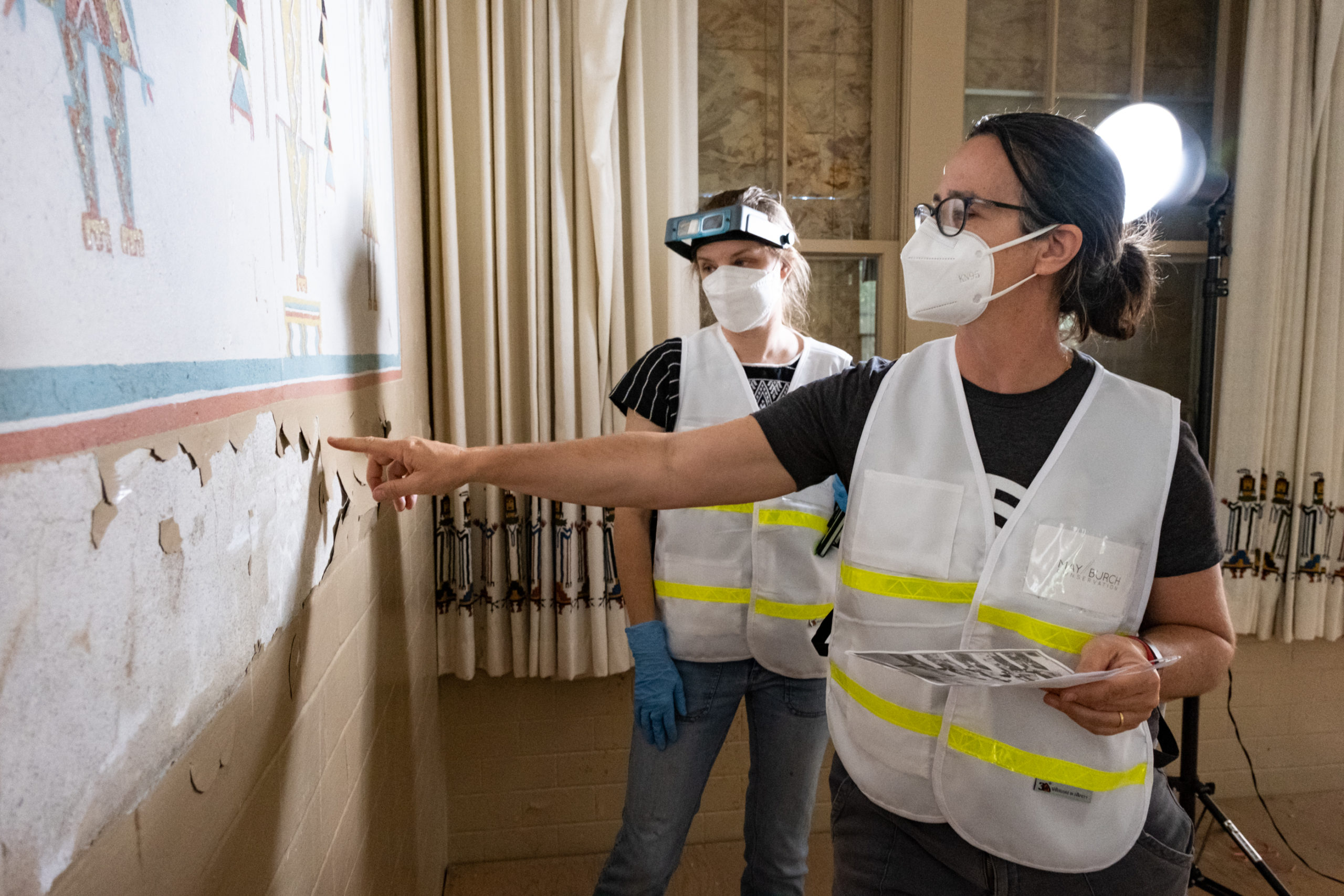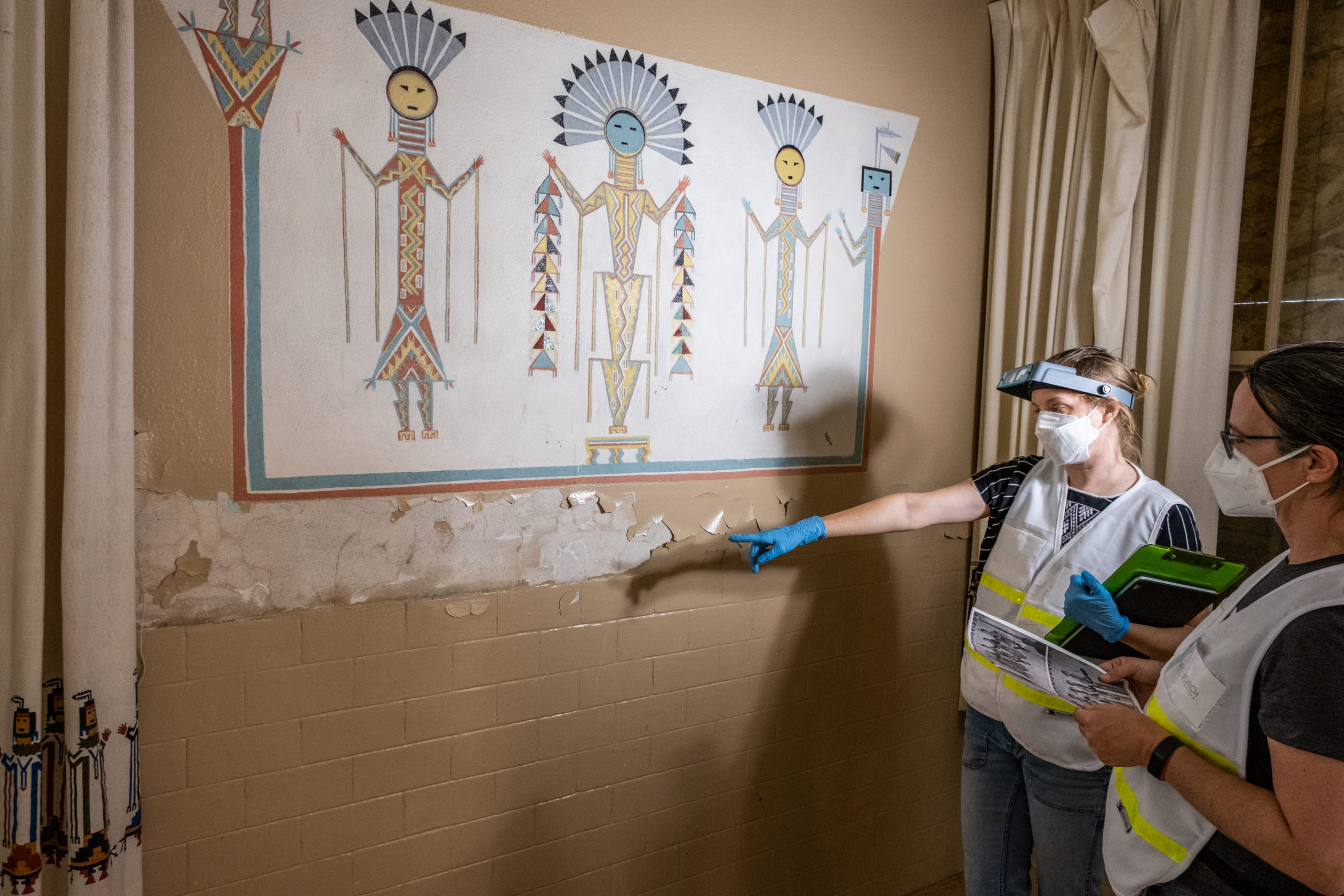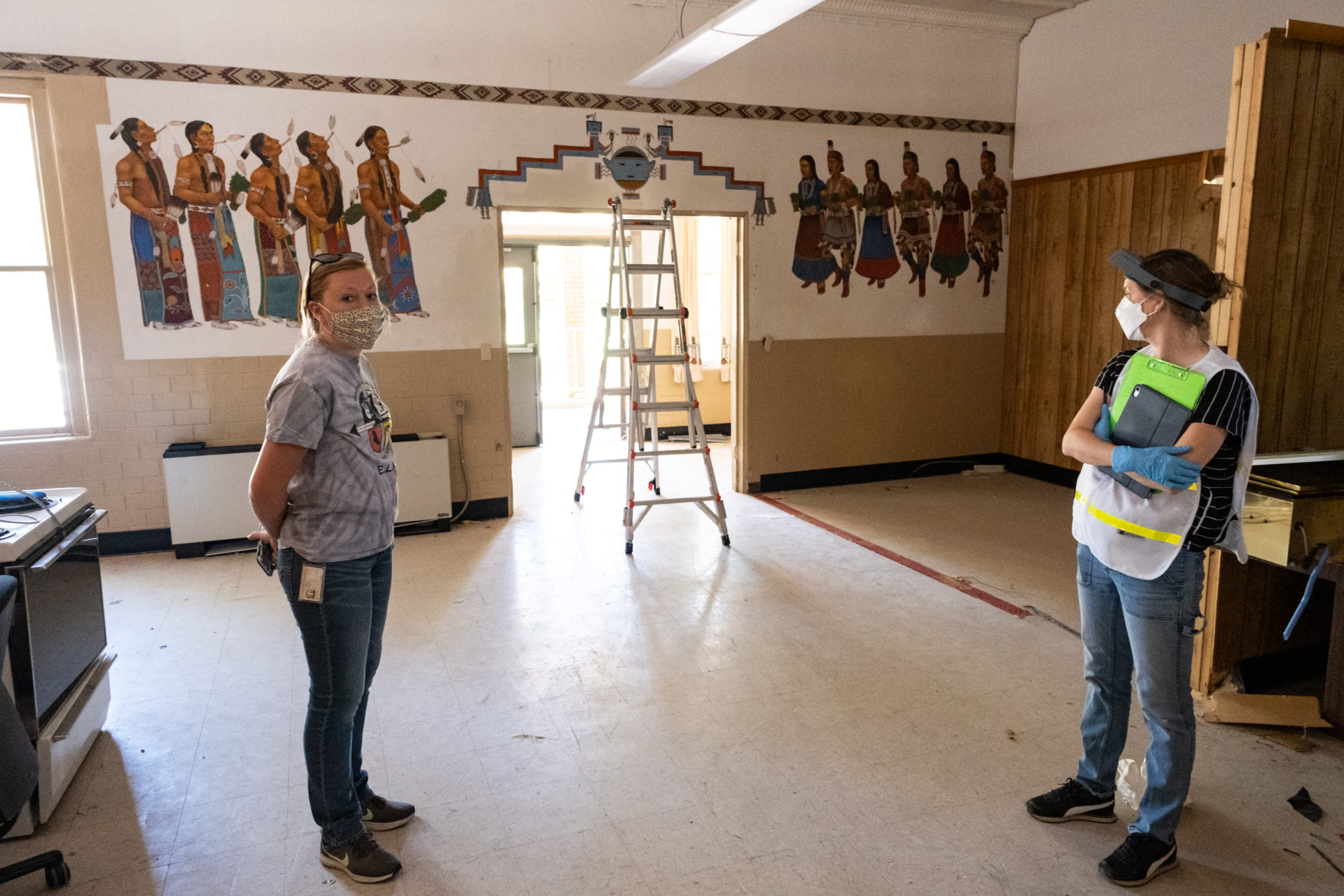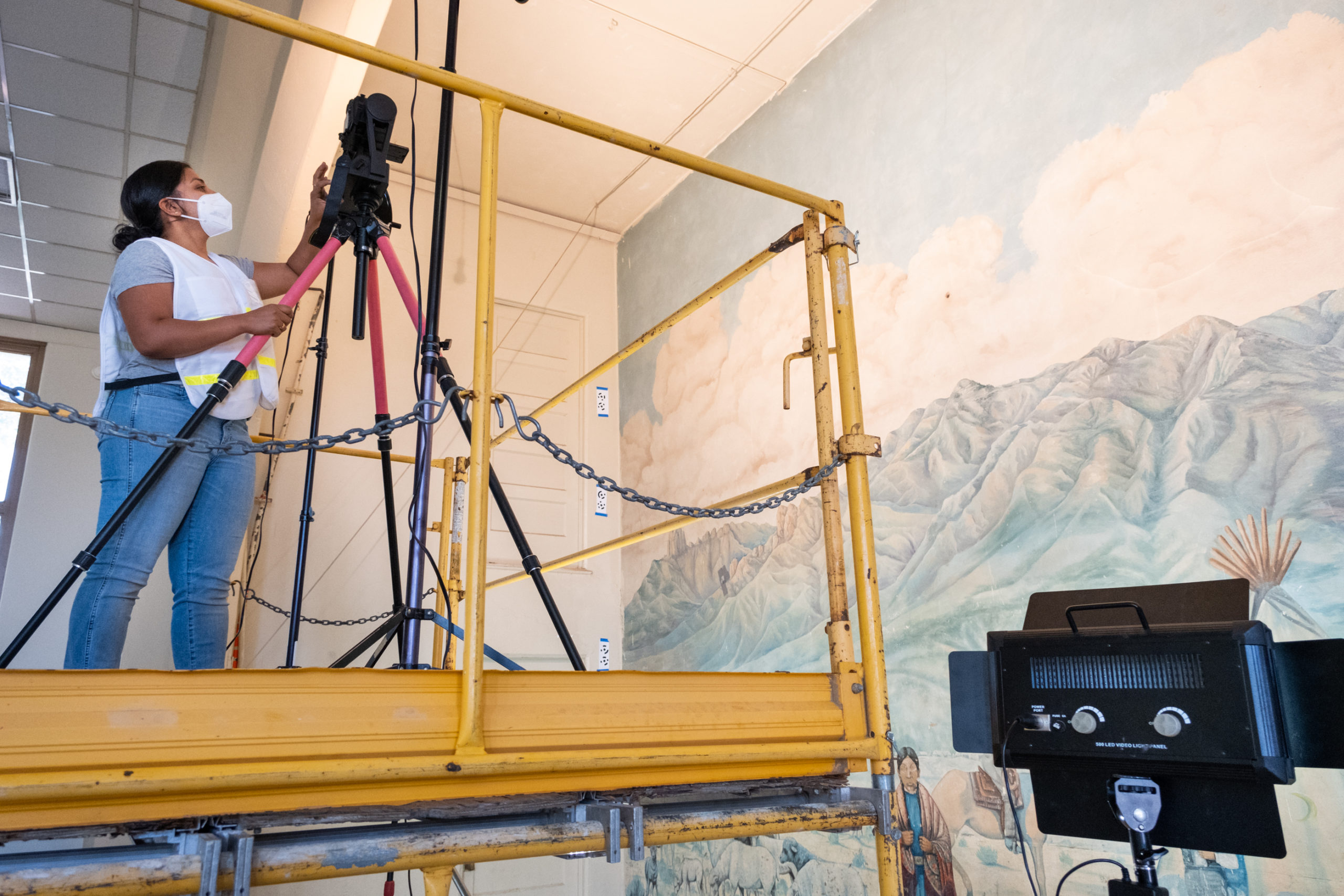The Southern Ute Environmental Programs Division (EPD) had a unique opportunity to contract with conservators from May/Burch Conservation to evaluate and document historic murals on the Southern Ute Tribal Campus in Ignacio. These murals were created in the 1930’s depicting traditional scenes and ceremonies, by Navajo (Dine) artist Sam Ray. The murals are located in the Head Start building and the neighboring Dining Hall, these now vacant buildings date back to the Boarding School era.
The project was made possible with Clean Air Act penalty funds through EPD. Oil & Gas Operators on the reservation have to operate by specific clean air regulations, if not in compliance, the Tribe’s inspectors issue an enforcement, or civil penalty. Paid to the Tribe, those funds are then set aside for environmental related projects. This project is tied to the abatement of the historic Head Start building and hence the preservation of the murals.
“It’s a really interesting story, the Air Quality Program has delegation for the Title V permitting program, we also do enforcement when they are not complying. The Southern Ute Indian Tribe is the only tribe that has that full authority,” explained EPD Division Head Mark Hutson. “We regulate everybody within the exterior boundaries; [we cover] permitting, compliance and enforcement. If they are in violation of the clean air act, we initiate a civil enforcement. We assess financial penalties for the violations.”
Those monies are then held in a fund for future projects, but unlike grant funded projects, there are fewer strings attached regarding how that money is spent.
“Monies from environmental harm — used to for environmental good,” Hutson stated. “Which included the digital preservation of the murals. [These are] monies that did not come out of the tribal budget per se, and we have used some of these monies to do other things, such as a clean-up and remediation project at Motor Pool a few years back.”
“Using those funds, EPD and Culture have been working on this together,” explained EPD General Assistance Program Manager, Alex Ratcliff, who took the lead on this project. “We have pretty much been doing everything hand in hand with Culture, working with Shelly [Thompson] and Garrett [Briggs.]”
“EPD led the way,” Hutson said. “We already have the environmental remediation project [going] at Head Start, while addressing the environmental concerns in that building, there came the mural. We recognized that something could happen to those buildings, and realized that no one had done any high-resolution work [documenting the murals]. We wanted to get that done first, so we worked with Culture on a request for proposals. It was a coordinated effort between Building Maintenance, Culture, and the Executive Office. We all worked together to make this project successful, and that [professional] documentation will be available for the future.”
“Both departments worked together to identify May/Burch Conservation for the project; their proposal was very impressive, they had a great understanding and respect for the project and Tribal Council’s wishes — in addition to their impressive resumes,” Ratcliff stated. “There is a sensitive history around the murals, [these buildings] being a place of good and bad memories for people.”
EPD developed the plan and went to Tribal Council back in April, along with Cultural Preservation to get direction on the Head Start building, to make sure that project would keep moving forward. Tribal Council directed their department to publish the RFP to obtain estimates for digital documentation and historic preservation of the murals in the Head Start school building and Dining Hall. As well as to digitally document the interior and exterior of the buildings; which includes the Annex Building.
May/Burch Conservation, Inc., who specializes in the conservation of wall paintings, murals, and painted architectural materials was the best candidate. “We provide a full range of conservation services, including collection surveys, condition assessments, maintenance planning, and conservation treatment of artworks on a variety of materials and substrates,” stated on the firm’s website.
“We all had a wonderful experience, everybody learned something from the process,” said Rachel Burch, Project Manager/Wall Painting Conservator on the project. “We all came away with a very positive feeling about everything. A lot of it’s in the preparation before we arrive, it’s a challenge, but also what makes the project interesting.”
The RFP closed beginning of June, EPD had May/Burch Conservation under contract by beginning of August. Their team was on site starting Monday, Aug. 10, working on Tribal Campus for the next five consecutive days. “This project would not have occurred without the cross departmental coordination from everyone involved; building maintenance, they were a huge help, Cultural Preservation, Executive Office, Ratcliff stated. “The fact that this project happened so quickly during the COVID-19 pandemic is a testament to teamwork!”
“Tribal Council had expressed the need for efficiency, in accomplishing this project as quickly as possible, Ratcliff said. “The teams worked in rotation to maximize time on site and document all aspects of the murals in a super-efficient manner.”
The Conservation Team included: Rachel Burch, Project Manager/Wall Painting Conservator and Kiernan Graves, Wall Painting Conservator. The duo focused on examining the paintings close-up, which included using a portable microscope at 50 to 200X magnification, and taking tiny samples which will provide further detail of the overlying paint layers of the murals. They also assessed the current condition of the murals, and will use all the written and photographic information gathered to advise on which conservation treatments are recommended for their best future preservation.
The Photogrammetry Team who worked on the mural in the Head Start Gymnasium, and those in the Dining Hall, was led by Samantha Emmanuel, Conservator and Evelynn Bird, Conservation Technician. Photogrammetry provides high-resolution, color-corrected and distortion-free images of the murals, which allow for both 2D and 3D photo reconstructions of them. Its detail and accuracy are incredible resources for the understanding of the paintings, and also for monitoring any change in their condition over time.
Joining them was Alan White, with AQYER, who performed 3D laser scanning of the three buildings, interior and exteriors of each. 3D laser scanning of the buildings, inside and out, provides a precise database in the form of a ‘point cloud’ which provides an accurate record of all the surfaces scanned, which can be used in many ways, in 2D and 3D, including creating ‘virtual tours’ of the buildings.
Lastly, John Meyer, Specialist building contractor, was brought onto the team, along with Architectural Conservator Kelly Wong, to help with figuring out the logistics of potential extraction of the murals, for preservation outside their present homes. Examination of the wall structures, and consultation with Engineers at WSC, will address the feasibility of moving the murals to another location.
“There were challenges that we faced with COVID,” Hutson emphasized “Coordinating the project to comply with the Incident Command Team’s directive. We accomplished the digital preservation and the 3D component — and we got it done in a week.”
EPD will be waiting on the final report from May/Burch Conservation which they anticipate to be complete by mid-September. The purpose of the photographs was solely documentation at this point, but opens the door for opportunity in the future. The information gained from the conservators will help guide decisions made by the Tribe in the near future.
“There is more to the project than just documenting, and laser mapping; we also asked them to develop options and costs regarding: saving the murals, conservation of the paint, or the wall, or moving the mural — what would that look like?” Ratcliff said “They are going to give us a bunch of different option on what we can do. The Pros and cons, cost etc. so that Tribal Council can make an informed descion when the time comes.”
Southern Ute councilmembers Marge Barry and Lorelei Cloud paid a visit to the Head Start and Dining Hall to see the conservation work for themselves, along with Cultural Preservation Director, Shelly Thompson who shared her own personal stories with the May/Burch team.
“We had a couple of visitors come by during the process, it was really great to see the contractors interact with people who had memories and to hear first-hand knowledge and perspective related to the murals; which feeds their research they are going to continue to do,” Ratcliff stated. “It was a really fun project, and EPD was happy to be a part of it. I personally learned a ton. The environmental and culture crossover is something I really enjoyed being a part of.”
Rachel Burch expressed her sincere thanks in particular to Alex Ratcliff and her colleagues for smoothing the way, and to the visitors from the Tribe who stopped by and shared their memories and stories of the murals. “One of our biggest surprises was realizing that the murals by Sam Ray in the Dining Hall may been previously restored. Burch stated. “We would love to have any information on when and by whom, to support our technical analysis of the paintings! If any other members of the Tribe have any memories or photographs they would like to share involving the murals, this would be very helpful for our work.”
May/Burch Conservation is asking for any first-hand historical information related to the Sam Ray murals. Rachel Burch can be reached at rburch@mayburchconservation.com or by phone at 310.384.8804.








